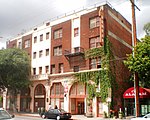Gilbert Lindsay Park
Parks in CaliforniaParks in Los AngelesParks in Los Angeles County, California
Gilbert Lindsay Park is an urban park located in Los Angeles City Council District 9, Los Angeles, California. It features fields/courts for soccer, baseball, and basketball, as well as an indoor gym, an auditorium, and a preschool.The Park is the former site of the Los Angeles Angels baseball park Wrigley Field.
Excerpt from the Wikipedia article Gilbert Lindsay Park (License: CC BY-SA 3.0, Authors).Gilbert Lindsay Park
East 42nd Place, Los Angeles Historic South-Central
Geographical coordinates (GPS) Address Nearby Places Show on map
Geographical coordinates (GPS)
| Latitude | Longitude |
|---|---|
| N 34.007059 ° | E -118.267433 ° |
Address
Gilbert Lindsay Community Center
East 42nd Place
90011 Los Angeles, Historic South-Central
California, United States
Open on Google Maps







